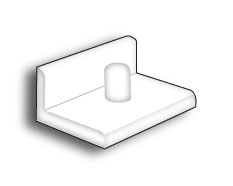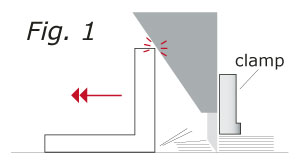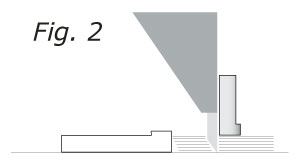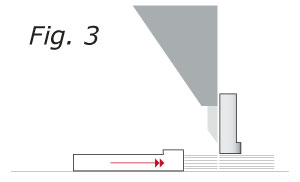 Here’s a guillotine cutter accessory that has been around as long as guillotine cutting machines. It's a simple jogging block which can be either homemade from wood or manufactured in plastic with a magnetic base. Their simple purpose is to keep cut pieces from scattering all over the cutter bed and to help in jogging cut sheets. Nearly every guillotine cutter operator uses one.
Here’s a guillotine cutter accessory that has been around as long as guillotine cutting machines. It's a simple jogging block which can be either homemade from wood or manufactured in plastic with a magnetic base. Their simple purpose is to keep cut pieces from scattering all over the cutter bed and to help in jogging cut sheets. Nearly every guillotine cutter operator uses one.
There are three things you can do to make them work better, especially if you're cutting small labels, tags or cards.
The problem is that as the trim size of the piece gets smaller, the height of the lift being cut will need to be made lower. If the jogging block is higher than the lift of paper, you end up with pieces  falling all over the cutter. As the knife comes down, the knife holder will hit the top of the jogging block, pushing it away from the pieces being cut before they are fully cut. It renders the jogger block useless.
falling all over the cutter. As the knife comes down, the knife holder will hit the top of the jogging block, pushing it away from the pieces being cut before they are fully cut. It renders the jogger block useless.
Fig. 1 (right) shows an exaggerated, side-view illustration of the problem in action.
There Is A Solution
 First, match the height of the jogging board to the height of the pile being cut. (Fig. 2) Typically the jogger board will be slightly higher than the pile being cut.
First, match the height of the jogging board to the height of the pile being cut. (Fig. 2) Typically the jogger board will be slightly higher than the pile being cut.
Determining the best pile height to cut involves a bit of trial and error. You might find for instance, that it's easy to cut a 5 inch lift of a 5x7" card, but the most you can get away with on a 1x2" card might be a 1 inch lift.
If your bindery does a large volume of cutting, it’s good to have several jogger boards on hand, each with different heights and widths. You can easily make a custom board from flat, smooth pieces of wood, preferably ones that don’t splinter easily. If you have a woodworker in your bindery or print shop, they will probably welcome the task.
Second, play with the weight of the jogger board. Too heavy a board and the result is that the cards fly all over the place despite having the right height. Too light and the board will slide away from the cut pieces as the knife cuts through.
The same applies to the magnetic boards; sometimes the magnetic side applies too much force and the block 'sticks' to the cutting table. In that case, try using the non-magnetic side down. No matter which board you're using, it should yield to the force of the knife bevel pushing on the stock, yet apply just enough resistance to keep the cards from falling over.
 Once you get the right jogger block for the job, there is one final step that will help cutter productivity as well as aid in packing. As the knife goes on the upstroke, hold the clamp down. Now use the jogger board to push the cut pieces back against the clamped lift—after all, it's perfectly flat—and you should end up with a nicely jogged lift of cut pieces. (Fig. 3, left) With a little practice most operators can do this very fast almost without thinking.
Once you get the right jogger block for the job, there is one final step that will help cutter productivity as well as aid in packing. As the knife goes on the upstroke, hold the clamp down. Now use the jogger board to push the cut pieces back against the clamped lift—after all, it's perfectly flat—and you should end up with a nicely jogged lift of cut pieces. (Fig. 3, left) With a little practice most operators can do this very fast almost without thinking.
While these may seem like obvious things to the experienced guillotine cutter operator, to the novice it is all new. I’ve seen plenty of guillotine operators struggle needlessly when a simple fix like this would have made all the difference.
As with most things in the bindery department, some experimentation is required. But the time spent is well worth it, since little improvements like this go a LONG way to boosting bindery productivity.
As always, we love to hear your experiences, comments and suggestions below!

